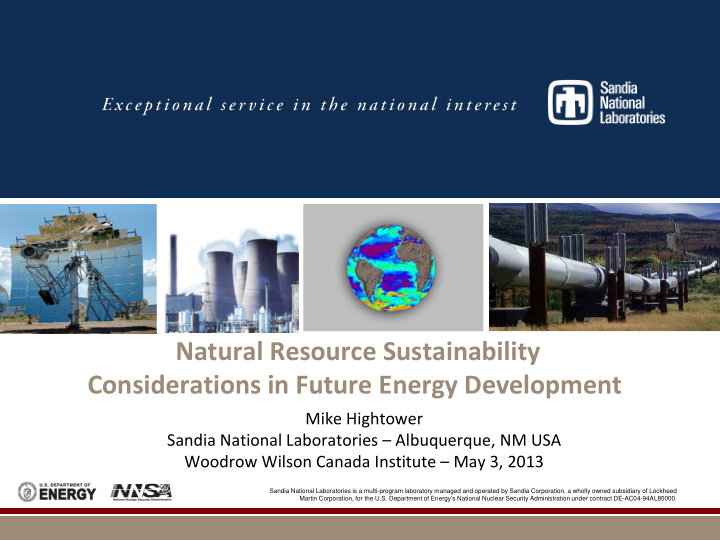



Photos placed in horizontal position with even amount of white space between photos and header Natural Resource Sustainability Considerations in Future Energy Development Mike Hightower Sandia National Laboratories – Albuquerque, NM USA Woodrow Wilson Canada Institute – May 3, 2013 Sandia National Laboratories is a multi-program laboratory managed and operated by Sandia Corporation, a wholly owned subsidiary of Lockheed Martin Corporation, for the U.S. Department of Energy’s National Nuclear Security Administration under contract DE-AC04-94AL85000.
Energy’s Impacts on Natural Resources are Often not System Focused Hydrogen Supply for Fuel Cells: CH 4 + 2H 2 O + heat → 4H 2 + CO 2 2
Energy Generation and Delivery – Becoming More and More Complex Infrastructure Resource Dependencies Dependencies Transmission and Air shed distribution Fuel Fuel/resource needs Land and transportation Water Water Capital Telecommunications Government 3
Natural Resource Issues in Energy Development As nations try to balance the demands and availability of water resources to support human health and economic development in the coming decades, it is clear that the water footprint, like the carbon footprint, will become an increasingly critical factor to consider in addressing reliable and sustainable energy development worldwide. Hightower, ASME Mechanical Engineering July 2011 “Water and watersheds is where the climate change rubber meets the road” Bernie Zak Sr. Scientist, Sandia, April 2013 There is no doubt that applying integrated resource-management principles could help provide the framework needed to meet future global energy and water needs in a more systematic and sustainable way. Hightower, Nature, March 2008 4
Energy-Water Interdependency Examples and General Issues and Trends Energy sector accounts for 8% of worldwide fresh water withdrawals 40% of withdrawals in developed countries – 40% US, 64% Canada Energy sector contributes to water quality issues Traditional oil and gas produced water; biofuels, oil sands, oil shale, gas shale, and coal bed methane ; water drainage from coal and uranium mines; power plant emissions and power plant impacts on surface water quality Water and waste water sector energy use is expected to grow substantially Growth in water treatment, new disinfection technologies, increased water transportation needs, etc. will increase energy intensity Water and waste water sector energy use could grow from 3% to 10% of total U.S. energy demand by 2030 30% of India’s energy use is for ground water pumping 5
Growing Limitations on Fresh Surface and Ground Water Availability in the U.S. Little increase in surface water storage capacity since 1980 Concerns over climate impacts on surface water supplies ( Based on USGS WSP-2250 1984 and Alley 2007) Many major ground water • aquifers seeing reductions in water quality and yield 6 (Shannon 2007)
Water Limitations Have Already Impacted Energy Development in the U.S. Recent energy facility permitting issues due to water availability 7
Climate Impacts on the Energy Sector Temp Droughts & More Frequent Rising Snow Cover Increase Floods Bigger Storm Events Sea Level Shrinking Impacts on… Transport Electricity Pipelines Refining Resource Production Transmission & Terminals Generation • Competition for • Damage to • Competition for • Damage to shore- • Reduced • Thaw access to water lines from access to water line facilities access to water subsidence and frost jacking storm events, • Increased • Increased • Increased • Increased peak temperature demand and loss production shipment flooding • Increased increases, of peak cooling interruptions interruptions setbacks • Loss of peak and floods capacity • Early season delays • Increased ice-load cooling • Loss of capacity • Increased • Increased variation capacity in existing • Pad damage congestion flooding pipelines • Reduced barge • Precipitation impact and other shipping • Increased wind on biofuels and solar seasons From Jan Dell, CH2MHill 8 variability
Climate Changes will Impact Precipitation and Regional Water Supplies and Resources Nat. Geo. April 2009 from IPCC 9
Many Energy Development Regions are where Climate Change Water Issues could be Significant 10
11 ENG505 Course Introduction
Changes in Water Availability are Impacting Watersheds, Ecosystems, and Services Current trends show that the number, size, and severity of wildland fires in the U.S. has grown significantly over the past four decades . . . . . 12
U.S. Oil and Gas Production Estimates Growth will be with hydraulic fracking and increased water use, Currently 3-5 million gallons per frack, and 100,000 ppm TDS flowback water 13
Electric Power Water Consumption and CO 2 Emissions will be reduced with More Natural Gas 14 ENG505 Course Introduction
Water Use and Consumption for Electric Power Generation Technologies Water Use Intensity (l/MWh e ) Cooling Plant-type Steam Condensing Other Uses Process Withdrawal Consumption Consumption Open-loop 80,000–200,000 ~800-1200 Fossil/ biomass steam turbine ~120 Closed-loop 1200–2400 1200–2000 Open-loop 100,000–240,000 ~1600 Nuclear ~120 steam turbine Closed-loop 2000–4400 1600–2900 Open-loop 30,000–80,000 400 Natural Gas Combined- 40 Cycle Closed-loop 900 700 Integrated Gasification Closed-loop 800 700 600 Combined-Cycle Carbon sequestration for ~85% increase in water withdrawal and consumption fossil energy generation Geothermal Steam Closed-loop 8000 1000-5000 200 Concentrating Solar Closed-loop 3000 2900 40 Wind and N/A 0 0 10 Solar Photovoltaic 15
Water Consumption for Different Transportation Fuel Alternatives 16
Energy Return on Investment and Water Return on Investment Considerations Imported Energy is Imported Water 17 17 ENG505 Course Introduction
Recommend
More recommend